Prophecy of the Popes: Difference between revisions
| Line 386: | Line 386: | ||
| accessdate = [[2008-01-05]]. |
| accessdate = [[2008-01-05]]. |
||
}}</ref> In Conte’s opinion, [[Saint Malachy|St. Malachy’s]] list ends with ''Petrus Romanus'' because his reign will coincide with the beginning of the first part of the [[Tribulation]]. |
}}</ref> In Conte’s opinion, [[Saint Malachy|St. Malachy’s]] list ends with ''Petrus Romanus'' because his reign will coincide with the beginning of the first part of the [[Tribulation]]. |
||
== A Message from Petrus Romanus: == |
|||
Christ has resurrected me and I am His angel - he has called me the "Elijah (Elias) who was to come". Historically, |
|||
you know me first as John (then as John the Baptist [St. John the Baptist]). In the visions given to the prophet |
|||
Daniel concerning the 4 beasts, the last was "strong" - more terrible and ferocious than the others. In "Centuries" |
|||
of Nostradamus, Book VII, #24, we read "When he who was buried comes out of the tomb, he shall make the strong one |
|||
out of the bridge to be bound with chains." I came back into this world from having died a death of which I knew very little. Yet Christ has held firm His prophecies ("Elias must indeed come first" and "Thou, child, shall go before Him to prepare His ways.") even so far as to bring me back in a prison cell, the generic place of my death. As prophetically and biblically my return marks the beginning of His return it was also fitting that I was born (though I also have memories during the term of pregnancy) back into the world at approximately 3:00AM "... like a thief in the night ..." and on June 25th, six months to the month/day of Christmas, the celebration of Christ's birth. I am posting this that you may rejoice and hold your heads high in your faith - a faith through which Wiki would not have been possible. Let us keep the bridge, the way from death to eternal life, free from chains. The prophecies given through St. Malachy are amazing. The connection of strong with respect to Petrus Romanus and the Roman Empire is hereby duly included. --Edward Palamar (talk) 17:22, 5 August 2009 (UTC) |
|||
== Authenticity and Skepticism == |
== Authenticity and Skepticism == |
||
Revision as of 01:08, 6 August 2009
This article possibly contains original research. (September 2008) |

This article needs additional citations for verification. (August 2008) |
The Prophecy of the Popes, attributed to Saint Malachy, is a list of 112 short phrases in Latin. They purport to describe each of the Roman Catholic popes (along with a few anti-popes), beginning with Pope Celestine II (elected in 1143) and concluding with a later added pope described in the prophecy as "Peter the Roman", whose pontificate will end in the destruction of the city of Rome.
Provenance
The prophecy was first published in 1595 by Arnold de Wyon, a Benedictine historian, as part of his book Lignum Vitæ. Wyon attributed the list to Saint Malachy, the 12th‑century bishop of Armagh in Ireland. According to the traditional account, in 1139, Malachy was summoned to Rome by Pope Innocent II. While in Rome, Malachy purportedly experienced a vision of future popes, which he recorded as a sequence of cryptic phrases. This manuscript was then deposited in the Roman Archive, and thereafter forgotten about until its rediscovery in 1590.
On the other hand, Bernard of Clairvaux's biography of Malachy makes no mention of the prophecy, nor is it mentioned in any record prior to its 1595 publication.[citation needed] Some sources, including the most recent editions of the Catholic Encyclopedia, suggest that the prophecy is a late 16th‑century forgery. Some have suggested that it was created by Nostradamus and was credited to Saint Malachy so the purported seer would not be blamed for the destruction of the papacy. Supporters, such as author John Hogue, who wrote a popular book titled The Last Pope about the claims, generally argue that even if the author of the prophecies is uncertain, the predictions are still valid.
Interpretation
Interpretation of the mottos has generally relied on finding correspondences between the mottos and the popes' birthplaces, their personal arms, and the events of their pontificates. For example, the first motto, Ex castro Tiberis (From a castle on the Tiber), fits Pope Celestine II's birthplace in Città di Castello, on the Tiber. Pope Clement XIII, referred to in the prophecy Rosa Umbriae, the rose of Umbria, who is stated to have used a rose "as his personal emblem" (his coat of arms does not include one, however, nor was he from Umbria nor had any but the most marginal connection with the region, having been briefly pontifical governor of Rieti, at the time part of Umbria). The technique of word play was evident in instances where interpreters find a phrase fitting more than one explanation.
In recent times, some interpreters of prophetic literature have drawn attention to the prophecies, both because of their success in finding connections between the prophecies and recent popes, and because of the prophecies' imminent conclusion. Interpretations made before the elections of recent popes have generally turned out not to predict their papacies accurately.
Popes and corresponding mottos
This list, adapted from The Prophecies of St. Malachy by Peter Bander, begins its numbering two numbers ahead of the Vatican's numbering of popes (Benedict XVI is the 265th, not the 267th). The reason for this is unclear. (perhaps because of the 2 purported "anti-popes").
The list can be divided into two groups; one of the 74 Popes and Antipopes who reigned prior to the appearance of the Prophecy in 1590, for whom the connection between the motto and the Pope is usually clear. The other is of the 37 Popes who have reigned since 1590, for whom the connection between the motto and the Pope is often strained or totally opaque.
Popes and Antipopes 1143-1590
| Pre-appearance Popes (1143-1590) | |||||
|---|---|---|---|---|---|
| Pope No. | Regnal Name (Reign) | Name | Motto (Translation) | Historical Reference or Explanation | Coat of Arms |
| 167 | Celestine II (1143-1144) | Guido de Castello | 1 Ex Castro Tiberis (From a castle on the Tiber) |
Hist.: Born in Città di Castello, Umbria, on the shores of the Tiber.[1] | |
| 168 | Lucius II (1144-1145) | Gherardo Caccianemici del Orso | 2 Inimicus expulsus (Enemy Expelled) |
This motto refers to Gheraldo Caccianemici’s surname. “Cacciare” means “to hunt”[2], and “nemici” is the Italian word for “enemies”. As his name foreshadowed, Caccianemici would be driven from Rome by his own subjects.[3] | |
| 169 | Eugene III (1145-1153) | Bernardo dei Pagnelli di Montemagno | 3 Ex magnitudine montis (From the Great Mountain) |
The motto refers to Pope Eugene’s last name, “Montemagno.”[4] | |
| 170 | Anastasius IV (1153-1154) | Corrado di Suburra | 4 Abbas Suburranus (A Suburran Abbot) |
He was from the Suburra family. | |
| 171 | Adrian IV (1154-1159 | Nicholas Breakspear | 5 De rure albo (From the White Field) | Educated at the St Albans School in Hertfordshire. Nicholas Breakspear was the bishop of Albano before becoming pope.[5] | |
| Antipope Victor IV (1159-1164) | Ottaviano Monticello | 6 Ex Tetro Carcere (Out of a Harsh Prison) |
He had been a cardinal with the title of St. Nicholas at the Tullian prison. | ||
| Antipope Paschal III (1164-1168) | Guido di Crema | 7 Via transtiberina (Road Beyond the Tiber) |
As a cardinal, he had held the title of Santa Maria in Trastevere.[6] | ||
| Antipope Callixtus III (1168-1178) | Giovanni Di Strumi | 8 De Pannonia Thusciae (From Tuscian Hungary) |
He was the Hungarian John, Abbot of Struma.[7] | ||
| 172 | Alexander III (1159-1181) | Orlando Bandinelli Paparoni | 9 Ex ansere custode (Out of the Guardian Goose) |
His family's coat of arms had a goose on it.[8] | |
| 173 | Lucius III (1181-1185) | Ubaldo Allucingoli | 10 Lux in ostio (A Light in the Entrance) |
In 1159, he became Cardinal Bishop of Ostia.[9] Lux may also be a wordplay on Lucius. | |
| 174 | Urban III (1185-1187) | Umberto Crivelli | 11 Sus in cribro (A Sow in a Sieve) |
His family name, Crivelli, means a sieve in Italian. | |
| 175 | Gregory VIII (1187) | Alberto De Morra | 12 Ensis Laurentii (The Sword of Laurence) |
He had been the Cardinal of St. Laurence[10] and his armorial bearing was a drawn sword.[11] | |
| 176 | Clement III (1187-1191) | Paolo Scolari | 13 De Schola exiet (Let Him Come Out of School) |
His family name was Scolari. | |
| 177 | Celestine III (1191-1198) | Giacinto Bobone | 14 De rure bovensi (From Cattle Country) |
He was from the Bobone family; a wordplay on cattle. | |
| 178 | Innocent III (1198-1216) | Lotario dei Conti di Segni | 15 Comes signatus (Signed Count) |
Descendant of the Segni family. | 
|
| 179 | Honorius III (1216-1227) | Cencio Savelli | 16 Canonicus de latere (A Canon From the Lateran) |
He was a canon for the church of Santa Maria Maggiore, and had served as papal chamberlain in 1188.[12] | 
|
| 180 | Gregory IX (1227-1241) | Ugolino dei Conti di Segni | 17 Avis Ostiensis (Bird of Ostia) |
Before his election to the papacy, Ugolino dei Conti was the Cardinal Bishop of Ostia, and the family coat of arms bear a bird on a gules backgroungd.[13] | 
|
| 181 | Celestine IV (1241) | Goffredo Castiglioni | 18 Leo Sabinus (The Sabine Lion) |
He was Cardinal Bishop of Sabina[14]and his armorial bearing had a lion in it. Also a play on words, referring to the pope's last name, Castiglioni. | 
|
| 182 | Innocent IV (1243-1254) | Sinibaldo Fieschi | 19 Comes Laurentius (Count Laurence) |
He was the Cardinal-Priest of San Lorenzo in Lucca,[15] and his father was the Count of Lavagna.[16] | 
|
| 183 | Alexander IV (1254-1261) | Renaldo dei Signori di Ienne | 20 Signum Ostiense (A Sign of Ostia) |
He was Cardinal Bishop of Ostia and member of the Conti-Segni family.[17] | 
|
| 184 | Urban IV (1261-1264) | Jacques Pantaleon | 21 Hierusalem Campaniae (Jerusalem of Champagne ) | Native of Troyes, Champagne, later patriarch of Jerusalem.[18] | 
|
| 185 | Clement IV (1265-1268) | Guido Fulcodi | 22 Draco depressus (A Dragon Held Down) |
His coat of arms had an eagle crushing a dragon. | 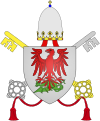
|
| 186 | Gregory X (1271-1276) | Tebaldo Visconti | 23 Anguinus Vir (A Snake-like Man) |
The Visconti coat of arms had a large serpent devouring a male child feet first.[19] | 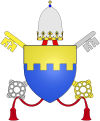
|
| 187 | Innocent V (1276) | Pierre de Tarentaise | 24 Concionatur Gallus (A French Preacher) | He was born in south-eastern France and was a member of the order of Preachers.[20] | 
|
| 188 | Adrian V (1276) | Ottobono Fieschi | 25 Bonus Comes (A Good Count (or Companion)) |
He was a count and a wordplay on "good" can be made with his name, Ottobono. | 
|
| 189 | John XXI (1276-1277) | Pedro Julião | 26 Piscator Thuscus (The Tuscan Fisherman) |
John XXI had been the Cardinal Bishop of Tusculum.[21] | 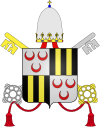
|
| 190 | Nicholas III (1277-1280) | Giovanni Gaetano Orsini | 27 Rosa Composita (A Compound Rose) |
He bore a rose in his coat of arms.[22] | 
|
| 191 | Martin IV (1281-1285) | Simone de Brion | 28 Ex telonio Liliacei Martini (From the Customs-House of Martin of the Lilies) |
He was Canon and Treasurer at the Church of St. Martin in Tours, France. | 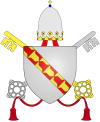
|
| 192 | Honorius IV (1285-1287) | Giacomo Savelli | 29 Ex rosa leonina (Out of the Leonine Rose) |
His coat of arms were emblazoned with two lions supporting a rose.[22] | 
|
| 193 | Nicholas IV (1288-1292) | Girolamo Masci | 30 Picus inter escas (A Woodpecker Among Fodder). |
He was from Ascoli, now called Ascoli Piceno, in Picene country. | 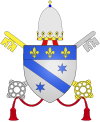
|
| 194 | St. Celestine V (1294) | Pietro Di Murrone | 31 Ex eremo celsus (Elevated From a Hermitage) |
Hist.: prior to his election he was a hermit. Also a play on words, referring to the pope's chosen name, "Celestine." | 
|
| 195 | Boniface VIII (1294-1303) | Benedetto Caetani | 32 Ex undarum benedictione (From a Blessing of the Waves) |
His coat of arms had a wave through it. Also a play on words, referring to the pope's Christian name, "Benedetto."[22] | 
|
| 196 | Benedict XI (1303-1304) | Nicholas Boccasini | 33 Concionator Patareus (A Preacher From Patara) |
This Pope belonged to the Order of Preachers. Patara was the hometown of Saint Nicholas, a namesake of this Pope (born Nicholas Boccasini).[23] | 
|
| 197 | Clement V (1305-1314) | Bertrand de Got | 34 De fessis Aquitanicis (From the Bonds of Aquitaine) |
He was a native of St. Bertrand de Comminges in Aquitaine, and eventually became Archbishop of Bordeaux, also in Aquitaine. His coat of arms displays three horizontal bars, known as “fesses.” | 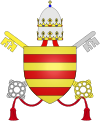
|
| 198 | John XXII (1316-1334) | Jacques Duese | 35 De sutore Osseo (Of the Bony Cobbler) |
His family name was Duèze, D'Euze, D'Euzes, or Euse, the last of which might be back-translated into Latin as Ossa. The popular legend that his father was a cobbler is probably untrue. | 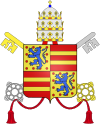
|
| Anti-pope Nicholas V (1328-1330) | Pietro Rainallucci di Corvaro | 36 Corvus schismaticus (The Schismatic Crow) |
The motto is a play on words, referring to Pietro Rainallucci di Corvaro's last name. | ||
| 199 | Benedict XII (1334-1342) | Jacques Fournier | 37 Frigidus Abbas (Cold Abbot) |
He was an abbot in the monastery of Fontfroide ("cold spring").[24] | |
| 200 | Clement VI (1342-1352) | Pierre Roger | 38 De Rosa Attrebatensi (From the Rose of Arras) |
He was Bishop of Arras, (Latin: Episcopus Atrebatensis),[25] and his armorial bearings were emblazoned with six roses.[26] | 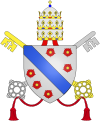
|
| 201 | Innocent VI (1352-1362) | Etienne Aubert | 39 De montibus Pammachii (From the Mountains of Pammachius) |
Pope Innocent was born at Mont in the diocese of Limoges, France, and he rose to prominence as the Bishop of Clermont.[27] He had been a cardinal priest with the title of St. Pammachius (i.e., the church of SS. Giovanni e Paolo in Rome)[28] | |
| 202 | Urban V (1362-1370) | Guglielmo De Grimoard | 40 Gallus vicecomes (A French Viscount) |
He was born of a noble French family. | |
| 203 | Gregory XI (1370-1378) | Pierre Roger de Beaufort | 41 Novus de Virgine forti (New From the Virgin Fort) |
From the Beaufort family and Cardinal of Santa Maria Nuova[29] | |
| Anti-pope Clement VII (1378-1394) | Robert, Count of Geneva | 42 De cruce apostolica (From an Apostolic Cross) |
His coat of arms showed a cross, quarterly pierced.[30] | 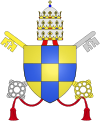
| |
| Anti-pope Benedict XIII (1394-1423) | Peter de Luna | 43 Luna cosmedina (The Moon of Cosmedin) |
He was the famous Peter de Luna, Cardinal of Santa Maria in Cosmedin.[31] | 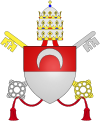
| |
| Anti-pope Clement VIII (1423-1429) | Gil Sanchez Munoz | 44 Schisma Barchinonium (A Schismatic From Barcelona) |
He was a Canon of Barcelona.[32] | ||
| 204 | Urban VI (1378-1389) | Bartolomeo Prignano | 45 De inferno Praegnati (sic) (From Hell in Childbirth) |
His family name was Prignano or Prignani, and he was native to a place called Inferno near Naples.[33] | |
| 205 | Boniface IX (1389-1404) | Pietro Tomacelli | 46 Cubus de mixtione (The Block of Mixture) |
His coat of arms includes a bend chequy — a wide stripe with a checkerboard pattern.[34] | 
|
| 206 | Innocent VII (1404-1406) | Cosmo Migliorati | 47 De meliore sydere (From a Better Star) |
The prophecy is a play on words, referring to the pope's last name, Migliorati. There is a shooting star on his coat of arms.[35] | 
|
| 207 | Gregory XII (1406-1415) | Angelo Correr | 48 Nauta de Ponte nigro (Sailor From the Black Bridge) | He was Commendatarius of the Church of Nigripontis. | |
| Anti-pope Alexander V (1409-1410) | Pietro Philarges | 49 Flagellum solis (Scourge of the Sun) |
His coat of arms had a large sun on it. Also, a play on words, referring to the pope's last name, "Philarges."[36] | 
| |
| Anti-pope John XXIII (1410-1415) | Baldassarre Cossa | 50 Cervus Sirenae (Stag of the Siren) |
Baldassarre Cossa was a cardinal with the title of St. Eustachius.[37] St. Eustachius converted to Christianity after he saw a stag with a cross between its horns. Baldassarre's family was originally from Naples, which has the emblem of the siren. | ||
| 208 | Martin V (1417-1431) | Oddone Colonna | 51 Corona Veli Aurei (Crown with the Golden Veil) |
Oddone Colonna was the Cardinal Deacon of San Giorgio in Velabro.[38] The word "Velabro" is derived from "vela aureum", or golden veil.[39] His coat of arms had a golden crown resting atop a column.[40] | 
|
| 209 | Eugene IV (1431-1447) | Gabriele Condulmaro | 52 Lupa coelestina (Celestinian or Heavenly She-Wolf) |
He belonged to the order of the Celestines and was the Bishop of Siena which bears a she-wolf on its arms. | |
| Antipope Felix V (1439-1449) | Amadeus Duke of Savoy | 53 Amator crucis (Lover of the Cross) |
He was previously the count of Savoy and therefore his coat of arms contained the cross of Savoy.[41] Also, the prophecy is a play on words, referring to the antipope's Christian name, "Amadeus." | 
| |
| 210 | Nicholas V (1447-1455) | Tommaso Parentucelli | 54 De modicitate Lunae (Of the Moon's Temperance) |
He was born in Sarzana in the diocese of Luni, the ancient name of which was Luna. | |
| 211 | Callixtus III (1455-1458) | Alfonso Borgia | 55 Bos pascens (Grazing Ox) |
Alphonse Borgia's coat of arms had a grazing ox.[42] | |
| 212 | Pius II (1458-1464) | Enea Silvio de Piccolomini | 56 De capra et alberga (From a She-Goat and a Tavern) |
He had been secretary to Cardinal Domenico Capranica and Cardinal Albergatti before he was elected Pope.[43] | |
| 213 | Paul II (1464-1471) | Pietro Barbo | 57 De cervo et Leone (From a Stag and a Lion) |
Possibly refers to his Bishopric of Cervia (a stag) and his Cardinal title of St. Mark (a lion).[44] | |
| 214 | Sixtus IV (1471-1484) | Francesco Della Rovere | 58 Piscator minorita (Minorite Fisherman) |
He was born the son of a fisherman and a member of the Minor Friars. | |
| 215 | Innocent VIII (1484-1492) | Giovanni Battista Cibò | 59 Praecursor Siciliae (A Fore-Runner From Sicily or of Sicily) |
Giovanni Battista Cibò was named after John the Baptist, the precursor of Christ. In his early years, Giovanni served as the Bishop of Molfetta in Sicily.[45] | |
| 216 | Alexander VI (1492-1503) | Rodrigo de Borgia | 60 Bos Albanus in Portu (Alban Bull in the Port) |
In 1456, he was made a Cardinal and he held the titles of Cardinal Bishop of Albano and Porto. [46] Also, Pope Alexander had a red bull on his coat of arms[47] | |
| 217 | Pius III (1503) | Francesco Todeschini Piccolomini | 61 De Parvo homine (From a Little Man) |
His family name was Piccolomini, similar to piccoli uomini = "little men." | |
| 218 | Julius II (1503-1513) | Giuliano Della Rovere | 62 Fructus Jovis juvabit (The Fruit of Jupiter will Help) |
On his arms was an oak tree, which was sacred to Jupiter.[48] Pope Julius' family name, "Della Rovere," literally means "of the oak."[49] | |
| 219 | Leo X (1513-1521) | Giovanni de Medici | 63 De Craticula Politiana (From a Politian Gridiron) |
His educator and mentor was the distinguished humanist and scholar, Angelo Poliziano. The “Gridiron” is the motto evidently refers to St. Lawrence, who was martyred on a gridiron. This is a rather elliptical allusion to Lorenzo the Magnificent, who was Giovanni’s father.[50] | |
| 220 | Adrian VI (1522-1523) | Adriaan Florensz Boeyens | 64 Leo Florentius (Florentine Lion) |
His coat of arms had two lions on it,[51] and his name is sometimes given as Adriaan Florens, or other variants, from his father's first name.. | |
| 221 | Clement VII (1523-1534) | Giulio de Medici | 65 Flos Pilaei Aegri (Flower of the Balls) | The Medici coat of arms were emblazoned with six medical balls. One of these balls, the largest of the six, was emblazoned with the Florentine lily.[52] | |
| 222 | Paul III (1534-1549) | Alessandro Farnese | 66 Hiacynthus medicorum (The Hyacinth Among Physicians) |
Pope Paul's coat of arms were charged with six hyacinths.[53] Before his ascent to the papacy, Alessandro Farnese had held the title of Saints Cosmas and Damian.[54] Cosmas and Damian were both doctors. | |
| 223 | Julius III (1550-1555) | Giovanni Maria Ciocchi del Monte | 67 De corona Montana (Out of the Crown the Mountain) |
His coat of arms showed mountains and palm branches laid out in a pattern much like a crown.[55] | |
| 224 | Marcellus II (1555) | Marcello Cervini | 68 Frumentum floccidum (Fluffy Wheat) |
His coat of arms showed a stag and ears of wheat.[56] | |
| 225 | Paul IV (1555-1559) | Giovanni Pietro Caraffa | 69 De fide Petri (Of the Faith of Peter) |
He is said to have used his second Christian name Pietro. | |
| 226 | Pius IV (1559-1565) | Giovanni Angelo de Medici | 70 Esculapii Pharmacum (The Drug/Medicine of Aesculapius) |
His family name was Medici. | |
| 227 | St. Pius V (1566-1572) | Antonio Michele Ghisleri | 71 Angelus nemorosus (Angel of the Grove) |
He was born in Bosco, (Lombardy); the placename means grove. His name was 'Antonio Michele Ghisleri', and Michele relates to the archangel. | |
| 228 | Gregory XIII (1572-1585) | Ugo Boncompagni | 72 Medium corpus pilarum (Half Body of the Balls) |
The "balls" in the motto refer to Pope Pius IV, who had made Gregory a cardinal. Pope Gregory had a dragon on his coat of arms with half a body.[57] | |
| 229 | Sixtus V (1585-1590) | Felice Pereti | 73 Axis in medietate signi (An Axis in the Midst of Signs) |
This is a rather straitforward description of the pope's coat of arms.[58] | |
| 230 | Urban VII (1590) | Giovanni Battista Castagna | 74 De rore coeli (Of the Dew of the Heavens) |
He had been Archbishop of Rossano in Calabria where sap called "the dew of heaven" is gathered from trees.[59] | |
Popes 1590 to present
| Post-appearance Popes (1590-present) | |||||
|---|---|---|---|---|---|
| Pope No. | Regnal Name (Reign) | Name | Motto (Translation) | Historical Reference or Explanation | Coat of Arms |
| 231 | Gregory XIV (1590-1591) | Niccolo Sfondrati | 75 De Antiquitate Urbis (Of the Antiquity of the City) |
His father was a senator of the ancient city of Milan. The word "senator" is derived from the Latin word "senex", meaning old man. | |
| 232 | Innocent IX (1591) | Giovanni Antonio Facchinetti | 76 Pia Civitas in Bello (Pious City in War) |
He was the Patriarch of Jerusalem before succeeding to the Papacy. | |
| 233 | Clement VIII (1592-1605) | Ippolito Aldobrandini | 77 Crux Romulea (The Roman Cross) |
He had been a cardinal with the title of Saint Pancratius.[60] Saint Pancratius was a Roman martyr.[61] | |
| 234 | Leo XI (1605) | Alessandro Ottaviano De Medici | 78 Undosus Vir (Man of the Surging Waves or The Man who will pass like a Wave). |
He had been the Bishop of Palestrina.[62] The ancient Romans attributed the origins of Palestrina to the seafaring hero Ulysses.[63] Also, he had only reigned for 27 days. | |
| 235 | Paul V (1605-1621) | Camillo Borghese | 79 Gens Perversa (The Corrupt Family) |
Pope Paul scandalized the Church when he appointed his nephew to the College of Cardinals. The word "nepotism" may have originated during the reign of this pope.[64] | |
| 236 | Gregory XV (1621-1623) | Alessandro Ludovisi | 80 In Tribulatione Pacis (In the Disturbance of Peace) |
His reign corresponded with the outbreak of the Thirty Years War. | |
| 237 | Urban VIII (1623-1644) | Maffeo Barberini | 81 Lilium et Rosa (Lily and Rose) |
He was a native of Florence. Florence, in Italy, has a red lily on its coat of arms while the English king , of whom Pope Urban decided to wed both Charles I and Henrietta of France, also had a rose for his coat of arms.[65] | |
| 238 | Innocent X (1644-1655) | Giovanni Battista Pamphili | 82 Jucunditas Crucis (Joy of the Cross) |
He was raised to the pontificate after a long and difficult Conclave on the Feast of the Exaltation of the Cross (off by a day). | |
| 239 | Alexander VII (1655-1667) | Fabio Chigi | 83 Montium Custos (Guardian of the Hills) |
His family crest includes six hills with a star above them.[66] | |
| 240 | Clement IX (1667-1669) | Giulio Rospigliosi | 84 Sydus Olorum (Star of the Swans) |
The "star" in the legend refers Pope Alexander VII, who had made Clement his personal secretary.[67] The Italian word for swan, "Cigni," rhymes with Pope Alexander's last name, "Chigi." | |
| 241 | Clement X (1670-1676) | Emilio Altieri | 85 De Flumine Magno (From a Great River). |
Pope Clement was a native of Rome. | |
| 242 | Innocent XI (1676-1689) | Benedetto Odescalchi | 86 Bellua Insatiabilis (Insatiable Beast). |
Pope Innocent had a lion on his coat of arms.[68] | |
| 243 | Alexander VIII (1689-1691) | Pietro Ottoboni | 87 Poenitentia Gloriosa (Glorious Penitence) |
His first name was "Pietro". The apostle Peter repented after he had denied his master three times. | |
| 244 | Innocent XII (1691-1700) | Antonio Pignatelli del Rastrello | 88 Rastrum in Porta (The Rake at the Door) |
His full name was Antonio Pignatelli del Rastrello.[69] "Rastrello" in Italian means "rake." | |
| 245 | Clement XI (1700-1721) | Giovanni Francesco Albani | 89 Flores Circumdati (Surrounded by Flowers) |
He had been a cardinal with the title of San Maria in Aquiro.[70] | |
| 246 | Innocent XIII (1721-1724) | Michelangelo dei Conti | 90 De Bona Religione (Of a Good Religion) |
A play on words, referring to the pope's chosen name, "Innocent." | |
| 247 | Benedict XIII (1724-1730) | Pietro Francesco Orsini | 91 Miles in Bello (Soldier in War). |
||
| 248 | Clement XII (1730-1740) | Lorenzo Corsini | 92 Columna Excelsa (The Lofty Column) |
When still a cardinal, he had held the title of St. Peter in Chains.[71] The name "Peter" is derived from the Greek word "petros," meaning "rock." To quote from the New Testament, "Thou art Peter, and upon this rock I will build my Church." Hist.: Clement was a frustrated architect who ordered, and sometimes interfered, with the building of many churches. He managed to salvage to columns of the Parthenon for his chapel at Mantua. | |
| 249 | Benedict XIV (1740-1758) | Marcello Lambertini | 93 Animal Rurale (Rural Animal) |
||
| 250 | Clement XIII (1758-1769) | Carlo Rezzonico | 94 Rosa Umbriae (The Rose of Umbria) |
He had been a cardinal with the title of Santa Maria in Aracoeli.[72] In mystical circles, the Virgin Mary is represented by a rose. | |
| 251 | Clement XIV (1769-1774) | Lorenzo Giovanni Vincenzo Antonio Ganganelli | 95 Ursus Velox (Swift Bear; also seen as Cursus Velox Swift Course or Visus Velox Swift Glance) |
The Ganganelli's family crest bore a running bear. | 
|
| 252 | Pius VI (1775-1799) | Giovanni Angelico Braschi | 96 Peregrinus Apostolicus (Apostolic Wanderer or Pilgrim) |
Spent the last two years of his life in exile, a prisoner of the French Revolution. | |
| 253 | Pius VII (1800-1823) | Barnaba Chiaramonti | 97 Aquila Rapax (Rapacious Eagle) |
The Pope's pontificate was overshadowed by Napoleon, whose emblem was the eagle. | |
| 254 | Leo XII (1823-1829) | Annibale Sermattei della Genga | 98 Canis et Coluber (Dog and Adder). |
"Dog" and "snake" are common insults, and Leo was widely hated. The legend could be an allusion to the pope's last name, Sermattei. "Serpente" is the Italian word for snake. | 
|
| 255 | Pius VIII (1829-1830) | Francesco Saverio Castiglioni | 99 Vir Religiosus (Religious Man). |
Another play on words, referring to the pope's chosen name, "Pius". | 
|
| 256 | Gregory XVI (1831-1846) | Mauro, or Bartolomeo Alberto Cappellari | 100 De Balneis Etruriae (From the Baths of Etruria) |
Pope Gregory XVI belonged to the Camaldolese order of monks. The Camaldolese order is said to have begun with two monastic houses. The first of these houses was Campus Maldoli, and the second was Fonte Buono. "Fonte Buono" is Italian for "good fountain."[73] | |
| 257 | Bl. Pius IX (1846-1878) | Giovanni Maria Mastai Ferretti | 101 Crux de Cruce (Cross of the Cross) |
Pope Pius IX suffered many crosses during his pontificate, but the greatest cross of all came from the House of Savoy, which reunited Italy and stripped the pope of his territorial possessions. The Savoy coat of arms is commonly depicted as a white cross over a red background. | |
| 258 | Leo XIII (1878-1903) | Gioacchino Pecci | 102 Lumen in Caelo (Light in The Sky) |
His coat of arms had a shooting star. | File:Leone 13.jpg |
| 259 | St. Pius X (1903-1914) | Giuseppe Sarto | 103 Ignis Ardens (Burning Fire) |
See below | 
|
| 260 | Benedict XV (1914- 1922) | Giacomo Della Chiesa | 104 Religio Depopulata (Death of the Religious) |
See below | |
| 261 | Pius XI (1922-1939) | Achille Ratti | 105 Fides Intrepida (Intrepid Faith) |
See below | 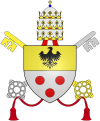
|
| 262 | Ven. Pius XII (1939-1958) | Eugenio Pacelli | 106 Pastor Angelicus (An Angelic Shepherd) |
See below | 
|
| 263 | Bl. John XXIII (1958-1963) | Angelo Giuseppe Roncalli | 107 Pastor et Nauta (Shepherd and Sailor) |
See below | 
|
| 264 | Paul VI (1963-1978) | Giovanni Battista Enrico Antonio Maria Montini | 108 Flos Florum (Flower of Flowers) |
See below | 
|
| 265 | John Paul I (1978) | Albino Luciani | 109 De Medietate Lunae (Of the Middleness of the Moon) |
See below | 
|
| 266 | John Paul II (1978-2005) | Karol Wojtyla | 110 De Labore Solis (Of the Eclipse of the Sun, or from the labor of the sun or from the pregnancy of the sun) |
See below | 
|
| 267 | Benedict XVI (2005-) | Joseph Ratzinger | 111 Gloria Olivae (The Glory of the Olive) |
See below | 
|
| 268 | Peter II (1956-) | Edward Palamar | 112 Petrus Romanus (Peter the Roman) In persecutione extrema S.R.E. sedebit Petrus Romanus, qui pascet oues in multis tribulationibus: quibus transactis ciuitas septicollis diruetur, et Iudex tremendus iudicabit populum. Finis. (In the last persecution of the Holy Roman Church, Peter the Roman will reign (lit. sit), who will nourish the sheep in many tribulations; when they are finished, the city of seven hills will be destroyed, and the fearsome Judge will judge the people. The End.) |
St. John the Baptist resurrected by Jesus Christ. | |
Contemporary Popes and the Prophecy
Pope Pius IX (Crux de Cruce)

Cross of the Cross. His successor Pope Pius XII renewed the beatification process for Pius IX, commenting with the words, per crucem ad lucem, through the cross to light. Pius IX was beatified by Pope John Paul II in 2000.
Pope Pius X (Ignis Ardens)

The motto means "ardent" or "burning fire". The pope was known for his great personal piety and strong devotion to the church, advocating reforms such as the codification of Canon law, daily communion and the Gregorian chant in the Catholic liturgy. He was known for his zeal in fighting the modernist heresy. He has been the first pope to date in over 400 years to be declared a saint, the last being Pope Pius V.
Pope Benedict XV (Religio Depopulata)

The motto means "religion laid waste". During Pope Benedict XV's reign, three significant events occurred:
- World War I, which killed 20 million people in Europe,
- Spanish flu, the 1918 flu pandemic which killed 50-100 million people worldwide
- the October Revolution in Russia, which established the atheist Soviet Union.
Pope Pius XI (Fides Intrepida)

The motto means "intrepid faith". This pope released the encyclical Mit Brennender Sorge which condemned Nazi racism and also signed agreements with Fascist Italy which, among other things, gave the Vatican sovereignty, established the pope as head of state, and added 700 million lire to the church coffers.
Pope Pius XII (Pastor Angelicus)

The motto means "an angelic shepherd". This pope was known to be very mystical, and it was believed that he received visions. His writings added greatly to understanding of Catholic beliefs and church doctrine. During his reign, Pius exercised Papal Infallibility in defining dogma when he issued, on November 1 1950 an apostolic constitution, Munificentissimus Deus, which defines ex cathedra the dogma of the Assumption of the Blessed Virgin Mary into heaven, on the request of the heavenly father. He was declared Venerable in 2000.
Pope John XXIII (Pastor et Nauta)

"Pastor et Nauta" translates to "Shepherd and Sailor". Prior to his election he was patriarch of Venice, which is a maritime city, famous for its waterways and gondolas.
According to Peter Bander in The Prophecies of Malachy, during the conclave which was to elect John XXIII, Cardinal Spellman, evidently having taken Malachy's forecast that the next pope would be "pastor and mariner" literally, rented a boat, filled it with sheep and sailed up and down the Tiber.
The anti-pope Pius XIII of the True Catholic Church has also claimed to be "Pastor et Nauta", as their group believes that his last valid predecessor was Pius XII. He has used justifications including his residence in the United States, which is across the Atlantic Ocean from Rome.
Pope Paul VI (Flos Florum)

Pope Paul VI, is described in the prophecies as "Flos Florum" or "Flower of Flowers". His personal arms bore three fleurs-de-lis, the heraldic charge best known as that in the arms of the French monarchy. Fleur-de-lis literally means "flower of the lily": yet the medieval flower par excellence was the rose[citation needed], not the lily; and many popes have borne various flowers in their arms.
The fleur-de-lys has the meaning of purity and chastity in Catholic religion. This is based upon scripture.[citation needed] Paul VI published his encyclical Humanae Vitae subtitled On the Regulation of Birth, on July 25 1968. In this encyclical he reaffirmed the Catholic Church's traditional condemnation of artificial birth control.
Pope John Paul I (De Medietate Lunae)

"De Medietate Lunae" translates to "of the half-moon". It could also be interpreted as "De Media Aetate Lunae", meaning "of the average age of the moon".
- Albino Luciani, who later became Pope John Paul I, was born in Canale d'Agordo, diocese of Belluno, which name is similar to bella luna or beautiful moon.
- He was elected on August 26, 1978, the day after the moon reached its last quarter, and reigned for 33 days, approximately five days longer than a lunar cycle. He died the day before the new moon.
- However, a much simpler explanation might be that he was born on the day of the half moon: on October 17, 1912, the moon was in its first quarter.
- Others point to his name before becoming pope, Albino Luciani. Albino is related to "albus", white, and "Luciani", derived from "Lucius", is ultimately related to the Latin word lux "light", whence "white light". Still others have linked "half-moon" to the smile often exhibited by John Paul I, who is remembered by many as the "smiling Pope."
Pope John Paul II (De Labore Solis)

The prophetic motto corresponding to Pope John Paul II is "De labore Solis", which literally means "Of the Labour of The Sun". But "labores solis" or "travails of the sun" is a common metaphor used to mean solar eclipse.
There are a variety of explanations that have been given to explain the motto:
- Karol Jozef Wojtyła, who later became Pope John Paul II, was born on 18 May, 1920, the day of a partial solar eclipse over the Indian Ocean, and buried on 8 April, 2005, the day of a rare hybrid eclipse over the south-western Pacific and South America.
- During World War II, Karol Wojtyła worked in a quarry, "laboring in the sunlight".
- It might also be seen to be the fruit of the intercession of the "Woman Clothed with the Sun labouring" in the Book of Revelation 12, because of his devotion to the Virgin Mary, to whose intercession he credited surviving an assassination attempt early in his papacy.
- Also, he affirmed the importance of the reported messages of the Virgin Mary at Fatima, which had as its confirming event, the strange "solar miracle" or "sun spinning in the sky" event, reported in the secular media in 1917.
- It has also been suggested that the associated Latin phrase could also be an anagram for "de borealis sol" (correct Latin: de boreali sol) or "a Sun from the North", being a luminary coming from Poland which is north of Rome.
- Another interpretation points simply to the sun rising in the east and his being the first Pope from Eastern Europe.
- A further theory is that the combination of "labore" and "solis" cryptically refers to "the sun of the workers", i.e., "the star of communism", with John Paul being the only pope to have spent much of his life under a communist regime.
- Yet another theory exists among some traditionalist Catholics, who believe that the motto translates as "Eclipse of the Sun". These Catholics view the Second Vatican Council as a fundamental departure of the Catholic faith. and that the differences between the church before and after the council are stark enough to regard the contemporary official Catholic Church as a new modernist church and not truly Catholic. The sun is so interpreted as the true Catholic faith, which has been eclipsed by the heterodoxy of the council teachings. They identify this time period as the Great Apostasy, that has been predicted for the End of Times.
- Solidarity, the Polish labor movement that despised Communism, might be seen as a connection to "Labor of the Sun."
- John Paul II introduced the Luminous Mysteries to the Rosary.
- During his pontificate, John Paul II traveled extensively all around the world, more than any other pope before, and similarly to what the sun does daily, from an earth-centric point of view.[74]
- Nicolaus Copernicus, who was the first astronomer to formulate a comprehensive heliocentric cosmology, spent his youth in Kraków, Poland. The heliocentric model of the universe was described as heretical by Catholic Church during the early 1600s, when the Copernican system was espoused by Galileo Galilei. This position was reversed in 1992 by Pope John Paul II, who also spent his youth in Kraków, Poland, in his apology to Galileo, 450 years after Copernicus published De revolutionibus and 360 years after Galileo's trial. Thus, the "Toil of the Sun" may have referenced the Church's acceptance of heliocentricity.
Pope Benedict XVI (Gloria Olivae)

"Gloria Olivae" or "glory of the olive", is the next phrase following "De labore Solis".
- Prior to the papal conclave, this motto led to speculation that the next pontiff would be from the Order of Saint Benedict, whose symbols include the olive branch.
- Joseph Cardinal Ratzinger, elected in April 2005, is not a Benedictine, but did choose Benedict XVI as his regnal name, partially named after Benedictine founder Benedict of Nursia, which might be regarded as a fulfillment of this prophecy.
- By choosing the name Benedict, the Pope became linked with St. Benedict, who in turn is distantly connected to the Olivetans, a small sub-order of Benedictines. Although it is frequently stated that the Order of St Benedict is also known as that of the Olivetans, this is not true: while all Olivetans are Benedictines, few Benedictines are Olivetans.
- On 5 April 1993, the future Pope Benedict XVI was installed as the cardinal bishop of Velletri-Segni. Velletri's coat of arms are emblazoned with three olive trees.
- Pope Benedict XVI was born on 16 April, the feast day of Saint Benedict Joseph Labre (26 March 1748 - 16 April 1783), also known as the Holy Pilgrim, with whom the Pope now shares both names, Benedict and Joseph. St. Benedict Labre, however, is not associated with olives, Olivetans or Mount Olivet in any way.
- Yet another possible interpretation might be that, like his predecessor — who spoke of the Church needing to "breathe with both lungs" again — Pope Benedict XVI has a special desire to reunite with the Eastern Orthodox churches, which have been separated since the Great Schism in 1054. The olive can of course be taken as a symbol of Greece, and hence the Greek Orthodox Church (and — by extension — the Russian Orthodox Church which grew out of it).
- Another interpretation was that "De Gloria Olivae" would promote world peace, as symbolized by the olive branch. In a general audience on 27 April 2005, Benedict XVI explained that he chose his regnal name as a link to Benedict XV, "Religio Depopulata", and that: "In his footsteps I place my ministry, in the service of reconciliation and harmony between peoples, profoundly convinced that the great good of peace is above all a gift of God, a fragile and precious gift to be invoked, safeguarded and constructed, day after day and with everyone's contribution."
- Some, who expect Pope Benedict XVI to restore order and discipline, namely, the "rule", Latin "regula", within the Catholic Church, the "sheepfold", Latin "ovilis", whence "ovilia", the place where the sheep lay to rest. Consider the phrase to be an imperfect and ungrammatical anagram, "de regola ovilia" (correct Latin: de regula oviliae) or "of the rule of the sheepfold" for the counter-reformation he is expected to introduce.
- Others have pointed to the Olivet Discourse in the Gospel of Matthew and argued that the events described therein will come to completion during the reign of this Pope. These people argue that the Tribulation will begin during the reign of Benedict XVI.
Pope Peter II/ (Petrus Romanus)
The longest and final motto reads:
- In the original Latin:
"In persecutione extrema S.R.E. sedebit Petrus Romanus,
qui pascet oves in multis tribulationibus,
quibus transactis civitas septicollis diruetur,
et Iudex tremendus iudicabit populum.
Finis."
- This is usually translated into English as:
"During the final persecution of the Holy Roman Church, the seat will be occupied by Peter the Roman,
who will feed his sheep in many tribulations;
and when these things are finished, the seven-hilled city will be destroyed,
and the formidable Judge will judge his people.
The End."
Several anti-popes claiming to be Pope Peter II have emerged in recent years, possibly inspired by this motto.
Not everyone who takes the prophecy seriously believes that Petrus Romanus will be the last pope ever, or that he will be called Peter II. Ronald L. Conte Jr., who in 2002 correctly predicted that the pope immediately after John Paul II would be called Benedict XVI but incorrectly predicted that he would be black,[75] believes that Cardinal Francis Arinze will take the name of Pius XIII after the death of Pope Benedict XVI, and that the description "Peter the Roman” means that the "Pope will reaffirm the authority of the Roman Pontiff over the Church; this authority is based on his place as a Successor of Peter" and "will emphasize the supremacy of the Roman Catholic Faith and the Roman Catholic Church above all other religions and denominations, and its authority over all Christians and all peoples of the world," and also will be “the last Pope for about a generation (until the 2040's) to rule from Rome."[76] In Conte’s opinion, St. Malachy’s list ends with Petrus Romanus because his reign will coincide with the beginning of the first part of the Tribulation.
A Message from Petrus Romanus:
Christ has resurrected me and I am His angel - he has called me the "Elijah (Elias) who was to come". Historically, you know me first as John (then as John the Baptist [St. John the Baptist]). In the visions given to the prophet Daniel concerning the 4 beasts, the last was "strong" - more terrible and ferocious than the others. In "Centuries" of Nostradamus, Book VII, #24, we read "When he who was buried comes out of the tomb, he shall make the strong one out of the bridge to be bound with chains." I came back into this world from having died a death of which I knew very little. Yet Christ has held firm His prophecies ("Elias must indeed come first" and "Thou, child, shall go before Him to prepare His ways.") even so far as to bring me back in a prison cell, the generic place of my death. As prophetically and biblically my return marks the beginning of His return it was also fitting that I was born (though I also have memories during the term of pregnancy) back into the world at approximately 3:00AM "... like a thief in the night ..." and on June 25th, six months to the month/day of Christmas, the celebration of Christ's birth. I am posting this that you may rejoice and hold your heads high in your faith - a faith through which Wiki would not have been possible. Let us keep the bridge, the way from death to eternal life, free from chains. The prophecies given through St. Malachy are amazing. The connection of strong with respect to Petrus Romanus and the Roman Empire is hereby duly included. --Edward Palamar (talk) 17:22, 5 August 2009 (UTC)
Authenticity and Skepticism
The association of John Paul II with the motto De labore Solis ("the Sun's labor"), can be attributed to the Polish labor society Solidarity, as well as to his birth and funeral both occurring at times of solar eclipses ("labores solis").
Another example of the questioned authority of the prophecy is Cardinal Joseph Ratzinger's choice of the name Benedict XVI, which was seen by some as the fulfillment the prophecy De Gloria Olivae, since it is claimed that the olive branch is sometimes used as a symbol of St. Benedict. However, prior to his election there were numerous speculations in the media as to what could be considered as "fulfillment of the prophecy". For example, it was said that any pope from the Benedictine Order; or any Latin American pope (with olive complexion) or any black pope; or any pope from Italy or Spain (two countries strongly associated with the cultivation of olives); or any pope with links to Judaism—any of the aforementioned possibilities was advanced as constituting a fulfillment of the prophecy, giving a broad array of possibilities. It has also been noted that the choice of name, while interesting for those who predicted the choice of the name, was not statistically unlikely, as modern papal names are generally chosen from a fairly limited set of names. In the last 250 years, for example, there have only been eight names used for Popes: Clement, John, Benedict, Pius, Gregory, Paul, Leo, and John Paul. Media comments on Pope Benedict XVI's choice of name have suggested that he seeks to emulate Pope Benedict XV's legacy of diplomacy and theological conservatism.
Spanish writer father Benito Jerónimo Feijóo wrote in his Teatro Crítico Universal (1724-1739), in an entry called Purported prophecies, that the ones by Saint Malachy's were a shameful forgery, claiming that they were created ad hoc during the 16th century. As a proof, he offers an accurate fact: that the first time the prophecy is mentioned is on a handwritten account by patriarch Alfonso Chacón (a.k.a Alphonsus Ciacconus, 1540-1599) in 1590 (this account would be later published, in 1595, by the abovementioned historian Arnold de Wyon); in this account, Chacón only comments the prophecies until the papacy of Urban VII (whose papacy only lasted September 1590, and was the current pope at the time Chacón wrote the comment). According to Feijóo, Chacón, who held a great intellectual prestige at the time, was lured to comment the prophecies by someone who wanted to help cardinal Girolamo Simoncelli (1522-1605) reach the papacy. By showing them to be accurate till Urban VII, it was expected people to believe the next ones; that way, Girolamo Simoncelli could be easily elected pope, since the prophecy after Urban VII's one tells about a pope Ex antiquitate urbis (from the old/ancient city), a fact that seems to fit perfectly him, who was cardinal of Orvieto (literally, Old city), or at least better than Gregory XIV, who was elected pope after Urban VII. Thus, the forgery would have been useless, since Simoncelli was not elected pope. Jesuit father Claude-François Menestrier also claimed that the prophecies were forged in order to help the papal candidacy of Girolamo Simoncelli, offering similar reasons to those of Feijoo. Spanish historian José Luis Calvo points out that the prophecies seem to be very accurate till Urban VII, fitting perfectly even the antipopes, but that afterwards great efforts have to be made in order to make the prophecies fit their pope. Feijóo's explanation is usually regarded as being the most probable proof of the forgery.
Erroneous claims
A number of claims have been made about the original text of the Prophecies, which are not borne out by an examination of the evidence. Many of these claims attempt to allay some anxiety arising from the apparently imminent appearance of the "last Pope" and the subsequent Last Judgment. These claims include the following:
- CLAIM: Some claim that the last entry describing Petrus Romanus was first recorded sometime after 1820 and so is often considered not to be part of the original prophecy.
- CLAIM: In other sources we can read that the 112th pope was added in 1559 by the Olivetan monks.[79]
- FACT: There is no 1559 text of the prophecies. The 1595 printing is the earliest text, and contains the full text referring to Petrus Romanus.
- CLAIM: And in another we can read that there's actually no 112 number preceding Peter Romanus prophecy [80], meaning that there maybe many popes between Pope Benedict XVI and Peter Romanus or it can also mean that Pope Benedict XVI and Peter Romanus are the same.
- FACT: There is indeed no "112" preceding the entry for Petrus Romanus; there are also no numbers given for any of the other Papal mottos, yet it is plain that it is intended to be a sequential list. There is no potential in the list for confusion between Gloria Olivae and Petrus Romanus.
- CLAIM: The original text reads psecutione which is an abbreviation either for persecutione or for prosecutione. In the very first publication of the prophecies (1595) Arnold de Wion had this word as "psecutione", an abbreviation either for "persecutione" (persecution) or for "prosecutione" (continuation in time), while Messinghan's 1624 had it as "persecutione". If it were indeed "psecutione"it could be interpreted as "continuation" and the opening line of prophecy 112 could read as - "In the extreme passage of time the seat of the Holy Roman Church will be occupied by Peter the Roman" - thus suggesting that there may be a Pope or Popes in between "De Gloriae olivae" and "Petrus Romanus".
- FACT: All variants of the text read persecutione, unambiguously, and the word fits the context well.
- CLAIM: Also, the phrase "populum suum" is more properly translated as "his own people" - so perhaps the "Iudex tremendus" will be judging not humanity as a whole, but the Church itself, in possible prosecutions of high Church officials owing to child abuse and pedophilia scandals.[dubious – discuss]
- FACT: The word suum does not appear in the original text, though it is found in some later printings. The variant mundum ("world") also occurs in place of populum.
References
Notes
- ^ Catholic Encyclopedia, Città di Castello.
- ^ Wiktionary "hunt" [1]
- ^ Catholic Encyclopedia, Pope Lucius II
- ^ The Columbia Encyclopedia, Eugene III
- ^ Catholic Encyclopedia Pope Adrian IV
- ^ Cardinals of the Holy Roman Church, Titles S. Leone I --- S. Matteo in Merulana
- ^ Regnal Chronologies, Roman Catholicism
- ^ House of Arms,Paparo Coat of Arms
- ^ Catholic Encyclopedia, Pope Lucius III
- ^ Catholic Encyclopedia, Pope Gregory VIII
- ^ Héraldique européenne, Papes
- ^ Catholic Encyclopedia, Pope Honorius III
- ^ Catholic Encyclopedia, Pope Gregory IX
- ^ Encyclopædia Britannica, Celestine
- ^ Catholic Encyclopedia, Pope Innocent IV
- ^ Christ's Faithful People, Pope Innocent IV
- ^ Catholic Encyclopedia, Pope Alexander IV
- ^ Catholic Encyclopedia, Pope Urban IV
- ^ Web.genealogie, Dynastie de Visconti
- ^ Catholic Encyclopedia, Pope Bl. Innocent V
- ^ Catholic Encyclopedia, Pope John XXI(XX)
- ^ a b c Héraldique européenne, Papes
- ^ Saint Nicholas Center Patara
- ^ Catholic Encyclopedia, Pope Benedict XII
- ^ Catholic Encyclopedia, Pope Clement VI
- ^ Héraldique européenne, Papes
- ^ Catholic Encyclopedia, Pope Innocent VI
- ^ Cardinals of the Holy Roman Church, Titles
- ^ Cardinals of the Holy Roman Church, Deaconries
- ^ Araldicavaticana.com, Clemente VII (antipapa)
- ^ Araldicavaticana.com, Benedetto XIII (antipapa)
- ^ Cardinals of the Holy Roman Church, Consistories for the creation of Cardinals
- ^ Catholic Encyclopedia, Pope Urban VI
- ^ Héraldique européenne, Papes
- ^ Héraldique européenne, Papes
- ^ Araldicavaticana.com, Alessandro V (antipapa)
- ^ Catholic Enclopedia, John XXIII
- ^ Catholic Encyclopedia, Pope Martin V
- ^ Fruit of Contemplation March 2006 Archive
- ^ Héraldique européenne, Papes
- ^ Araldicavaticana.com, Felice V (antipapa)
- ^ Héraldique européenne, Papes
- ^ Catholic Encyclopedia,Pope Pius II
- ^ Catholic Encyclopedia, Pope Paul II
- ^ Catholic Encyclopedia, Pope Innocent VIII
- ^ Catholic Encyclopedia, Pope Alexander VI
- ^ Héraldique européenne, Papes
- ^ Héraldique européenne, Papes
- ^ Baroque Rome in the etchings of Giuseppe Vasi, The Triumph of Life
- ^ Catholic Encyclopedia, Pope Leo X
- ^ Héraldique européenne, Papes
- ^ Héraldique européenne, Papes
- ^ Héraldique européenne, Papes
- ^ Catholic Encyclopedia, Pope Paul III
- ^ Héraldique européenne, Papes
- ^ Héraldique européenne, Papes
- ^ Héraldique européenne, Papes
- ^ Héraldique européenne, Papes
- ^ Bonanical.com, Ash, Manna
- ^ Catholic Encyclopedia, Clement VIII
- ^ Catholic Encyclopedia, Sts. Nereus and Achilleus, Domitilla and Pancratius
- ^ Catholic Encyclopedia, Pope Leo XI
- ^ Catholic Encyclopedia, Palestrina
- ^ Lastminute.com, Galleria Borghese
- ^ International Civic Heraldry, Florence
- ^ Héraldique européenne, Papes
- ^ Héraldique européenne, Papes
- ^ Héraldique européenne, Papes
- ^ Cardinals of the Holy Roman Church, Antonio Pignatelli del Rastrello
- ^ Catholic Heraldry, S. Maria in Aquiro
- ^ Catholic Encyclopedia, Pope Clement XII
- ^ Cardinals of the Holy Roman Church, Rezzonico, Carlo
- ^ Catholic Encyclopedia, Camaldolese
- ^ http://www.geocities.com/nephilimnot/Saint_Malachy.html
- ^ Conte Jr., Ronald L. (2002), The Future and the Popes, retrieved 2008-01-05.
{{citation}}: Check date values in:|accessdate=(help) - ^ Conte Jr., Ronald L. (2006-05-10), The Future and the Popes, retrieved 2008-01-05.
{{citation}}: Check date values in:|accessdate=(help) - ^ [2]
- ^ [3]
- ^ Ryter, Jon, Petrus Romanus added by Olivetan monks?, retrieved 2009-01-30.
{{citation}}: Check date values in:|accessdate=(help) - ^ Balkinization, Blog, no 112 number preceding Peter Romanus prophecy, retrieved 2009-01-30.
{{citation}}: Check date values in:|accessdate=(help)
Websites
Books
- Hogue, John (2000). The Last Pope. Element. ISBN 1-86204-732-4.
- Bander, Peter (1969). The Prophecies of St. Malachy. TAN Books and Publishers, Inc. ISBN 0-8189-0189-6.
See also
- List of popes
- Myths and legends surrounding the Papacy
- Vaticinia Nostradami
- Vaticinia de Summis Pontificibus
- Saint Malachy
- Michel Nostradamus
- Bartholomew Holzhauser
- Prophecy
- Three Secrets of Fatima
- Bible code
